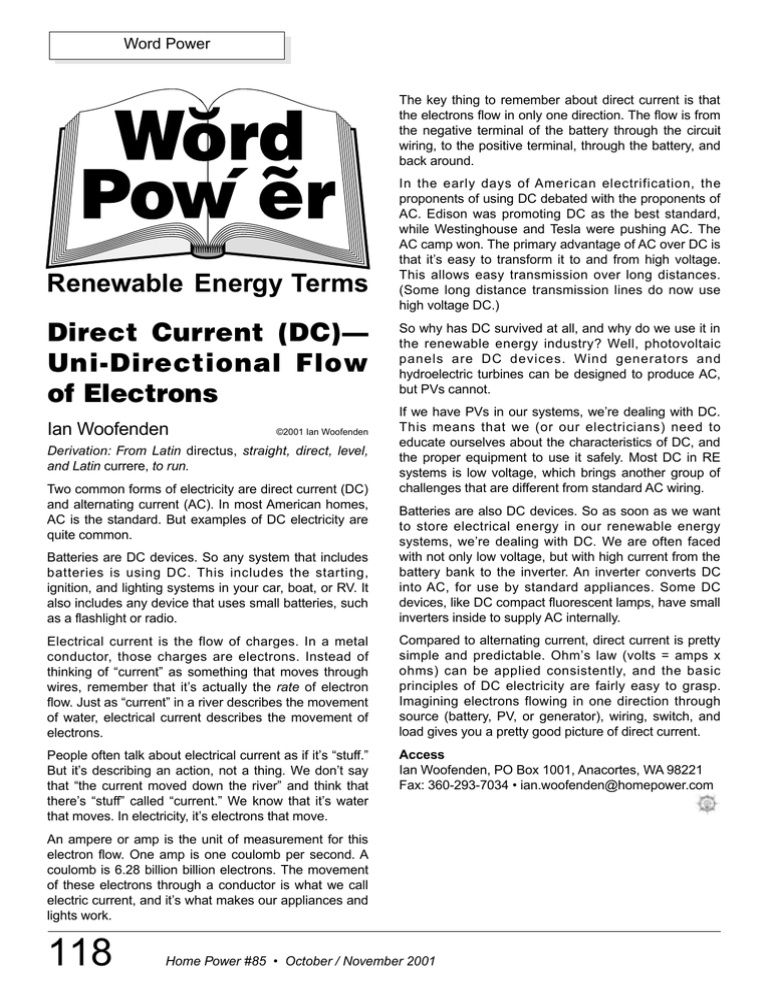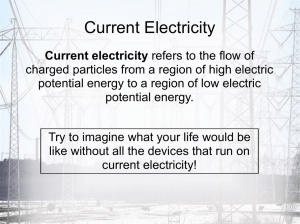Direct Current (DC)— Uni-Directional Flow of Electrons Renewable
advertisement

Word Power The key thing to remember about direct current is that the electrons flow in only one direction. The flow is from the negative terminal of the battery through the circuit wiring, to the positive terminal, through the battery, and back around. Renewable Energy Terms Direct Current (DC)— Uni-Directional Flow of Electrons Ian Woofenden ©2001 Ian Woofenden Derivation: From Latin directus, straight, direct, level, and Latin currere, to run. Two common forms of electricity are direct current (DC) and alternating current (AC). In most American homes, AC is the standard. But examples of DC electricity are quite common. In the early days of American electrification, the proponents of using DC debated with the proponents of AC. Edison was promoting DC as the best standard, while Westinghouse and Tesla were pushing AC. The AC camp won. The primary advantage of AC over DC is that it’s easy to transform it to and from high voltage. This allows easy transmission over long distances. (Some long distance transmission lines do now use high voltage DC.) So why has DC survived at all, and why do we use it in the renewable energy industry? Well, photovoltaic panels are DC devices. Wind generators and hydroelectric turbines can be designed to produce AC, but PVs cannot. If we have PVs in our systems, we’re dealing with DC. This means that we (or our electricians) need to educate ourselves about the characteristics of DC, and the proper equipment to use it safely. Most DC in RE systems is low voltage, which brings another group of challenges that are different from standard AC wiring. Batteries are DC devices. So any system that includes batteries is using DC. This includes the starting, ignition, and lighting systems in your car, boat, or RV. It also includes any device that uses small batteries, such as a flashlight or radio. Batteries are also DC devices. So as soon as we want to store electrical energy in our renewable energy systems, we’re dealing with DC. We are often faced with not only low voltage, but with high current from the battery bank to the inverter. An inverter converts DC into AC, for use by standard appliances. Some DC devices, like DC compact fluorescent lamps, have small inverters inside to supply AC internally. Electrical current is the flow of charges. In a metal conductor, those charges are electrons. Instead of thinking of “current” as something that moves through wires, remember that it’s actually the rate of electron flow. Just as “current” in a river describes the movement of water, electrical current describes the movement of electrons. Compared to alternating current, direct current is pretty simple and predictable. Ohm’s law (volts = amps x ohms) can be applied consistently, and the basic principles of DC electricity are fairly easy to grasp. Imagining electrons flowing in one direction through source (battery, PV, or generator), wiring, switch, and load gives you a pretty good picture of direct current. People often talk about electrical current as if it’s “stuff.” But it’s describing an action, not a thing. We don’t say that “the current moved down the river” and think that there’s “stuff” called “current.” We know that it’s water that moves. In electricity, it’s electrons that move. Access Ian Woofenden, PO Box 1001, Anacortes, WA 98221 Fax: 360-293-7034 • ian.woofenden@homepower.com An ampere or amp is the unit of measurement for this electron flow. One amp is one coulomb per second. A coulomb is 6.28 billion billion electrons. The movement of these electrons through a conductor is what we call electric current, and it’s what makes our appliances and lights work. 118 Home Power #85 • October / November 2001


